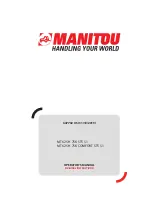
Technical Data
Fluids, Lubricants and Capacities
176
9821/6100-4
176
Sulfur
The level of sulfur is governed by emissions legislations. Regional regulation, national regulations or
international regulations can require a fuel with a specific sulfur limit. The sulfur content of the fuel and the fuel
quality must comply with all existing local regulations for emissions. The guidelines for the correct sulfur level
for specific territories. Consult all applicable regulations before selecting the fuel for a given engine application.
Table 26.
Territory
Fuel Requirements from 2007
EPA
Low sulfur (500 ppm) maximum
Sulfur/power
Low sulfur (300 ppm)
maximum for less than or
equal to 19 kW
Sulfur (1000 ppm) maxi-
mum for greater than 19
kW
EC
Models
402D-05 and 403D-07
403D-11, 403D-15,
403D-15T, 403D-17,
404D-15, 404D-22,
404D-22T, and
404D-22TA
Non-regulated territories Sulfur limit of less than 4000 ppm
Table 27.
Territory
Fuel Requirements from 2010
EPA
Low sulfur (15 ppm) maximum
Sulfur/power
Low sulfur (10 ppm) max-
imum for less than or
equal to 37 kW
Sulfur (300 ppm) maxi-
mum for greater than 37
kW
EC
Models
402D-05 403D-07
403D-11 403D-15
403D-15T 403D-17
404D-15
404D-22 404D-22T, and
404D-22TA
Non-regulated territories Sulfur limit of less than 4000 ppm
By using the test methods 'ASTM D5453, ASTM D2622, or ISO 20846 ISO 20884', the content of sulfur in
LSD (Low Sulfur Diesel) fuel must be below 500 PPM 0.05%. By using the test methods 'ASTM D5453, ASTM
D2622, or ISO 20846 ISO 20884', the content of sulfur in ULSD fuel must be below 15 PPM 0.0015%. The
lubricity of these fuels must not exceed wear scar diameter of 0.46mm. The fuel lubricity test must be performed
on a HFRR, operated at 60°C (139.9°F). Refer to 'ISO 12156-1'.
In some parts of the world and for some applications, high sulfur fuels above 0.5% by mass might only be
available. Fuel with very high sulfur content can cause engine wear. High sulfur fuel will have a negative impact
on emissions of particulates. High sulfur fuel can be used provided that the local emissions legislation will allow
the use. High sulfur fuel can be used in countries that do not regulate emissions.
When only high sulfur fuels are available, it will be necessary that high alkaline lubricating oil is used in the
engine or that the lubricating oil change interval is reduced.
Lubricity
This is the capability of the fuel to prevent pump wear. The fluid's lubricity describes the ability of the fluid to
reduce the friction between surfaces that are under load. This ability reduces the damage that is caused by
friction. Fuel injection systems rely on the lubricating properties of the fuel. Until fuel sulfur limits were mandated,
the fuel's lubricity was generally believed to be a function of fuel viscosity.
The lubricity has particular significance to the current low viscosity fuel, low sulfur fuel and low aromatic fossil
fuel. These fuels are made in order to meet stringent exhaust emissions. A test method for measuring the
lubricity of diesel fuels has been developed and the test is based on the HFRR method that is operated at 60°C
(139.9°F). Refer to 'ISO 12156 part 1 and CEC document F06-A-96' for the test method.
Содержание 2069289
Страница 2: ......
Страница 4: ...9821 6100 4 Notes...
Страница 12: ...Notes viii 9821 6100 4 viii...
Страница 18: ...Notes 6 9821 6100 4 6...
Страница 30: ...Notes 18 9821 6100 4 18...
Страница 41: ...Operation Entering and Leaving the Operator Station 29 9821 6100 4 29 Figure 15 A A Glazing breaker...
Страница 45: ...Operation Windows 33 9821 6100 4 33 Figure 21 A B A Latch B Frame...
Страница 98: ...Notes 86 9821 6100 4 86...
Страница 136: ...Maintenance Service Points 124 9821 6100 4 124 Cab and Exterior Figure 98 R S R Track gearbox S Track tensioner...
Страница 207: ...Technical Data Warranty Information 195 9821 6100 4 195 Figure 154 11000h 132 Month h...
Страница 208: ...Notes 196 9821 6100 4 196...










































